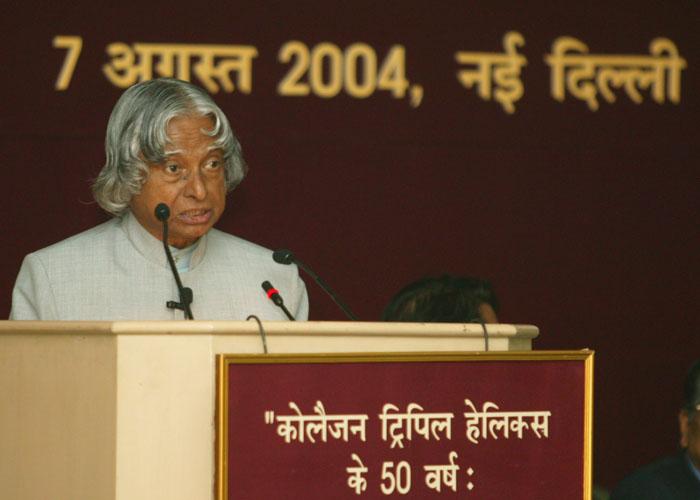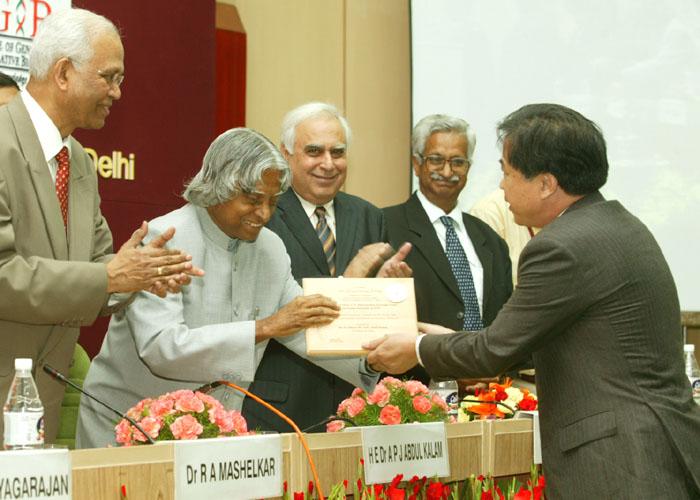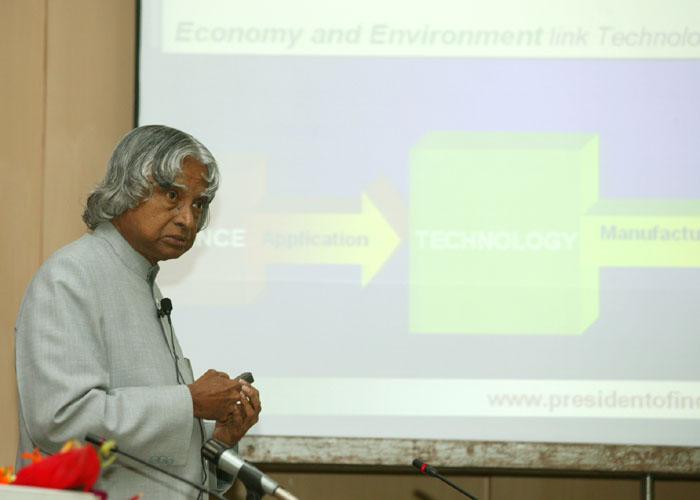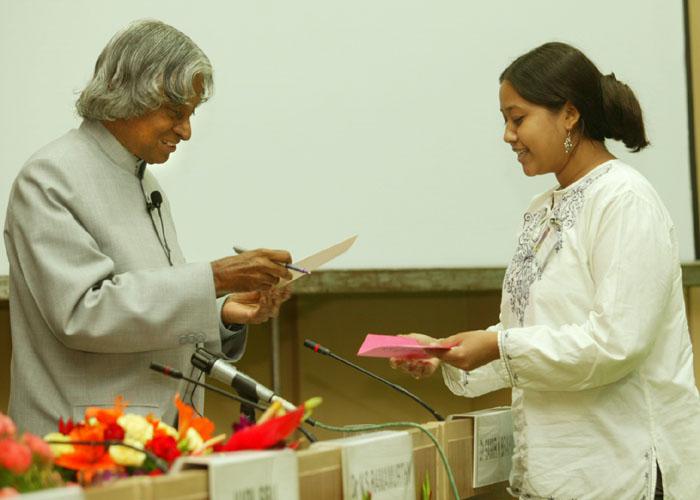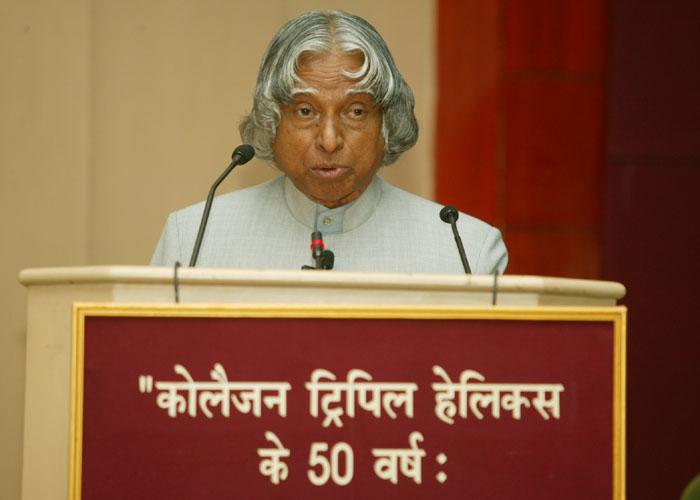Address At The Celebration Of 50 Years Of The Discovery Of The Triple Helical Structure Of Collagen By Prof G N Ramachandran
New Delhi : 07-08-2004
Scientific & Technological Challenges
I am indeed delighted to participate in the celebration of the discovery of the Triple Helical Structure of Collagen by Prof G.N.Ramachandran (GNR). My greetings to organizers, scientists, academicians, students and distinguished guests participating in this function.
GNR's Contribution
GNR?s life is indeed an example for emulation by all scientists which was a fusion of curiosity, creativity and problem solving for successful missions. GNR, was wondering how to go about with x-ray diffraction and x-ray crystallography base with application to bio-molecules as a main theme. A question by GNR to JD Bernal, the famous crystallographer and chemist who was on a visit to India in 1942 said all the structure proposed so far for collagen were unsatisfactory and GNR could take a look at that. How to get collagen was indeed a big problem for GNR at that time. When he presented his problem to Dr.Nayudamma, the then Director of CLRI, within few days procured a tube full of collagen from Australia. This helped GNR to publish the first innovative paper on the collagen structure, which gave strikingly original triple helix ? it appeared in the journal Nature in August 7, 1954. The proposed structure consisted of three separate helical chains, with their axis parallel to the fiber axis, stacked in a hexagonal array. This structure was not only innovative it also provided better quantitative agreement with the X-ray data. Collagen is today finding large-scale application in the treatment of third degree burn injuries, since it has been found to have extradinary healing properties. Also collagen has led to a separate branch of biology named structural biology, which is being taught in many universities. I was thinking what thoughts I can share with young researchers and students on the occasion of celebrating 50 years of the Discovery of the Triple Helical Structure of Collagen by Prof G N Ramachandran. I have selected the topic ?Scientific and technological challenges?.
Technology Interfaces
Technology is the non-linear tool available to humanity which can affect fundamental changes in the ground rules of economic competitiveness. Science is linked to technology through applications. Technology is linked to economy and environment through manufacture. Economy and environment linked to technology promotes prosperity to the society.
Technology Through Ages
Through out the last 120 centuries, unique cultures have come into existence due to advancement in technology. The first 118 centuries had a dominance of primarily stone, bronze & iron ages. The last two centuries have seen rapid development of chemical age. The advancements made in material science and technology gave the impetus for both nuclear and biological age to flourish. Succession of these technology periods has involved progression from simpler materials to more complex forms of science and engineering. We are today at the convergence of Nano, Bio and Information tech-nologies. This age, I feel will create historical revolution and we must be at driver?s seat to contribute towards this societal change.
When I think of Nanoscience and Nanotechnology, I am reminded of three personalities. First person is Richard Feynman, who described the concept of 'building machines" atom by atom in his talk at Caltech titled "There is plenty of room at the bottom". The second person is Eric Drexler, who wrote the book titled 'Nano Systems, Molecular machinery, manufacturing and computation". The third person is Prof. CNR Rao, who pioneered and fostered the nano science research in India. Since independence, the country had all along been taking recourse to technology for societal changes and economic prosperity. A nation that is alert should be sensitive to the changes that take place to the technological fabric of the world and prepare itself for the arrival of newer changes in the horizon.
As the country was acquiring the technologies of steel, agriculture, space, missiles and IT, we grew to be anywhere between third to fifth nation in figure of merit. In information technology we have a possibility of becoming the third knowledge power. We believe that nanotechnology would give us an opportunity, if we take an appropriate and timely action, we can become one of the important technological nations in the world.
Technology in India
India after independence was determined to move ahead with planned policies based on socialist pattern through five-year plans. On account of the green revolution, India is now self sufficient in food. The operation flood has made India, the largest producer of milk in the world. Health services have also been improved since independence with increase in life expectancy from 33 to 64 years, fall in infant mortality from 148 to 71 per thousand, and eradication of diseases like small pox, cholera through vaccination etc. Small-scale industries provide a significant percentage to the national GDP. India is in a position to design, develop and launch world-class communication and remote sensing satellites. India is having capability of building large Thermal and Nuclear power stations. Defence research has led to many significant developments in weapon systems like strategic and cruise missiles, sonars, underwater weapons, light combat aircraft, tanks, electronic warfare systems and various armours. India has a strong base in the development of information technology and the country is progressing in hardware and software business of more than $66 billion. Yet, India is a developing country.
Emerging India
As you are aware the first independent movement started in India in 1857. This was the first vision for the nation. Our forefathers and freedom fighters struggled for 90 years continuously and achieved independence in the year 1947. After 1947, our science and technology has brought about self-sufficiency in food, milk and improved the standard of living to a certain extent. In spite of continuous work during the last fifty seven years 26% of our one billion population are still below poverty line. They require habitat, they require healthcare, they require potable water, they require education, they require power and above all they require employment opportunities to improve their living standards. This I am told by the economic pundits that this can be achieved if our economy can grow over 10% GDP annually. Scientists and technologists have to work persistently to achieve this target for making India into a prosperous and happy nation by 2020.
Integrated action
To meet the need of one billion people, we have the mission of transforming India into a developed nation. We have identified five areas where India has a core competence for integrated action: (1) Agriculture and food processing (2) Reliable and Quality Electric power, Surface transport and Infrastructure for all parts of the country. (3) Education and Healthcare (4) Information and Communication Technology (5) Strategic sectors. These five areas are closely inter-related and if well done would lead to national, food, economic and security.
Green Revolution-II
India has to now embark upon the Second Green Revolution which will enable it to further increase its productivity and diversity in the agricultural sector. The second green revolution will have the farmers in focus, farming technology as the friend, food processing and marketing as partners and the consumers as the angels to be satisfied. From now on to 2020, India would have to gradually increase the production to around 400 million tonnes of grains. The increase in the production will have to be done under the reduced availability of land from 170 million hectares to 100 million hectares with reduced water availability. We should also learn to diversify to meet specific consumer preferences, export markets and also in the interest of ecological balance. This is to be achieved through information access to all stakeholders and not with central controls or restriction of movements of agro products. The challenges for the scientists and technologies would be in the areas of development of seeds that would ensure good yield even under constraints of water and land with ecologically balanced farming. The challenges for the scientist is indeed a knowledge graduation from characterization of soil to the matching of the seed with the composition of the fertilizer, water management and evolving new pre-harvesting techniques for such conditions. The domain of farming would enlarge from grain production to food processing and marketing. Newer forms of co-operative entities are required to be established for ensuring maximum benefit to the farmers. E-marketing concepts may also be put into practice to provide farmers choices in selling. Some of the areas which need focus are: soil upgradation, dry land agriculture, temperature and salinity resistant seeds and minimum water cultivation. There have been successful experiments carried out by TIFAC team in Bihar, where per hectare output of wheat has been tripled by farmers in collaboration with agricultural scientists through scientific methods. Such experiments can be replicated in many parts of our country, carefully tailored to local conditions. The earnings of the participating farmers have remarkably improved. This is a crucial socio-economic need. Access to food will need enhancement of purchasing power of the rural and urban population. This can only come out of employment generation through entrepreneurship and through increase in the incomes of existing farmers by techniques adopted by the TIFAC team briefly mentioned above.
Areas of research in Bio-technology
The key areas of research in bio-technology are Gene therapy, Gene modifiers, drugs designed for individuals, nano-medicines, developing a living cell, DNA repair, stem cells, drug delivery nano-robots and tissue culture.
Stem Cell Research
The recent identification and characterization of progenitors with stem cell properties has opened up new avenues that may be useful for treating functional impairments caused by the death of specific cell population. The stem cell may help restore functioning of certain defective organs, by repopulating or rescuing the damaged cells from further degeneration. There will be a revolution in the medical treatment for heart care, cancer, visually impaired and mentally challenged. It is essential to launch an integrated national stem cell research program. During my visit to various laboratories, I happened to see the beginning of stem cell research for different purposes including brain research. I would like to share with you two very important stem cell research applications in the field of cardiology and visual impairment. When I met Dr. P. Venugopal, a famous cardiac surgeon, he told me about his experiences. He said in one of the cardiac diseases, where conventional, medical and surgical treatment were ineffective because of the affliction of the heart muscle, use of autologous bone marrow stem cells implantation into the diseased heart muscles had been applied in order to improve the function of heart muscle. This kind of application of this procedure is the latest and very few cases have been done in the world, the first time in India. This is expected to open new frontiers in the treatment of patients for regeneration of heart muscles, there by giving new hope for the patients suffering from end stage heart disease. The stem cells are being tried in other diseases like diabetes in order to offer cure for the patients suffering from long term and intractable diabetes. This is being applied by injecting the stem cells into the patient?s artery supplying the pancreas. Similarly, my friend Dr. Taraprasad Das has administered the stem cells in the affected retina portion of the eye region with success.
Space
Today, competence has been established for advanced remote sensing and communication satellites and their applications. Our launch services and satellites are cost effective and we should enter into the global market aggressively. The exploration of the moon through ?Chandrayaan? will electrify the entire country, particularly young scientists and children. I am sure the moon mission is just a start towards further planetary explorations and manned missions which will lead to Mars exploration vital for our economic needs.
Development of reusable launch system
Currently, global space industry has a capacity to launch over 200 tonnes of satellites every year. However, the forecast is that projected demand will consume less than half of this established capacity. Thus a bitter price war is on to capture this limited market. The cost of access to space forbids further expansion of space activities. The Indian concept of hyper-plane, a fully reusable system is an innovation in rocketry providing a payload fraction of 15%, drastically reducing the launch cost. Therefore, it is an opportune moment for India to work with international agencies and launch a major universal mission to provide the benefit of space technology to the whole mankind.
God?s Creation of Nano-materials
Whenever I go for a morning walk in the Mughal Garden, I see the peacocks dancing with its colorful feathers, during this season. When I look at the deep and beautiful colors on the feathers of the peacock in the Rashtrapati Bhavan, I have often wondered how even after many years, the color of the peacock feather does not fade away. I recall as a young kid, I used to keep peacock feathers in my books. This phenomenon of long lasting original color to the peacock has come from the God's own creation of Nano materials, coated in a peacocks feather and they diffract light, which gives us the rich colors. Every thing in this universe ? from giant stars to our bodies work on molecular scale. Our hearts and lungs are big objects but all the processes take place at the molecular level. Therefore, everything in our body and in the physical universe is already based on nanotechnology. Observation of the nature and the role of science in understanding it from our research in Nano sciences can be converted into a technological product by using the same or similar Nano materials which gave the natural color for the peacock feather, as part of our shirts, sarees, fabric and apparels. It is a welcome destination for science to mature into technology and become a product of utility for the society.
Nano-bio-info technology
The world market in 2004, is for nano materials, nano tools, nano devices and nano biotechnology put together is expected to be over hundred billion dollars. It has been noticed that the fastest growing area among these is nanobiotechnology. Carbon nano tubes and its composites will give rise to super strong, smart and intelligent structures in the field of material science. Nano Bio medical sensors will play a major role in glucose detection and endoscopic implants. Drug delivery system will revolutionize the health-care to a large extent. Molecular switches and circuits along with nano cell will pave the way for the next generation computers. Ultra dense computer memory coupled with excellent electrical performance will give the society low power, low cost, nano size and yet faster assemblies. The last four decades have also effected the packaging concept. Electronics packaging of the past has given way to the present Microsystems packaging and the shift in the trend is now towards the futuristic nano packaging.
Integrated approach for nano-structures to manufacturing
For us to succeed in manufacturing of nano products and their deployment we need to tackle the issues of science and technology, product development and societal aspects in an integrated way. Judging by the past experience of the country in driving technology missions like in Aerospace, Agri-culture, Atomic energy and IT, I am confident that, if we take in a mission mode with a clear-cut vision, the country will reap the benefits of nanoscience and technology.
Research Areas
CNT based Photo-voltaic Cell: Presently silicon based photo-voltaic cell have only an efficiency of 13 to 15%. This has become a big challenge for converting solar energy into power. Research has shown promise of increasing the efficiency of the photo-voltaic cell to 40 to 50% using CNT. This will have significant effect in the capital investment of solar energy plants. Treatment for Parkinson?s disease and Epilepsy: The primary symptoms in Parkinson Disease as you all aware are tremor or trembling in hands, arms, legs, jaw, and face, rigidity or stiffness of the limbs, slowness of movement and impaired balance. Prof Varadan has devised a wireless system for monitoring and control of Parkinson?s disease. The system consists of an implantable DNA insert in the head region for generating a pulse to the nerve system; controlled either by a modified pacemaker or smart hat. A Passive polymer based gyro sensors, which are implanted in the tremor location. The sensor gets the power from the Pacemaker and the Pacemaker then reads the tremor motion. The Pacemaker then generates the pulse in the implanted device in the head to control the tremor. This appears to be a promising line of treatment for such diseases. It has been reported that 13 patients affected by Parkinson diseases had full recovery.
Energy
Our generating capacity has to get tripled by 2020 from the existing hundred thousand Megawatts of power. This has got to be achieved through three different sources namely hydel capacity, nuclear power and non-conventional energy sources primarily through solar energy. This capacity build up will need large scale power generation through solar energy and other renewable energy sources to an extent of 1,00,000 mega watts. Nuclear, Hydel and thermal stations will cater to the balance 2,00,000 mega watts.
Water
Globally, there are a few solutions to solve water shortage. The solutions are redistribution of water, water re-cycling and prevention of wastage, rain-water harvesting and inter-linking of rivers. What is the solution as a scientists and technologist can provide for these missions? We must find scientific solutions to these missions so the missions are executed in a cost effective manner maintaining the eco-logical balance and bio-diversity.
One important solution is to create new perennial sources of fresh water by sea-water desalination. India attaches importance to research and technological solution for various desalination processes. But we are only in pilot plant stage. We need to work for large volume desalination plants, which can cater to the needs of big cities both Multi Stage Flash and Reverse Osmosis. Our scientists should also carryout research in the areas drinking water generation. Another area of research involves culturing of water through sea water bacteria, releasing hydrogen ions which can be converted into drinking water. This is probably a long term solution to water problem. Regional cloud seeding with the cooperation of participating states with the effective seeding techniques needs to be explored in our country.
Earthquake prediction
In many places in our planet, we experience severe earthquakes resulting in loss of life, loss of wealth and in some cases it destroys the decades of progress made by the country and its valuable civilizational heritage. India has earthquake problems periodically in certain regions. Earthquake is a sub terrain phenomenon and predicting this from space observations would be a great challenge space scientists. I am sure that if you all work with the determination that you have always exhibited, we will reach the light on the other side of the tunnel.
Earthquakes occur when the crust reaches a critical state, emission of electromagnetic signals before final rupture is theoretically plausible, notably in the ultra low frequency (ULF) range and very low frequency (VLF) range. It is hoped that well organized electromagnetic monitoring may provide unique observational information on the pre-slips.
Conclusion
For fast national development, I am convinced that Nano is the greatest building block for healthcare, structural material, in electronics, automation etc and will become the platform for new cutting edge technologies to grow for better living of the mankind. We need to integrate nano-technology with bio-technology, information and communication technology and space technology for the benefit of mankind in education, healthcare, communication water, power, materials, manufacturing and disaster management,
As you all know there is a big debate going on, whether human cloning should be encouraged or not. This is one of the pet subjects of bio-scientists and technologists. I would like to share with you my own personal view. God has created human being after millions of years of genetic creation and engineering. Every one of us carry genes with memory and the experience of our fore fathers who lived millions of years ago. I don?t think the man can compete with God in engineering these cumulative characteristics. Hence, cloning of human beings should not be permitted. However, it is essential to clone various organs of the human body system like eye, liver, heart, pancreas, kidney etc., which can help in repair and rejuvenation of the human system.
My best wishes to all the members of the scientific community for success in your scientific and technological missions.
May God bless you.
Questions asked by the Students at the Symposium of 50 years of Triple Helix: A Celebration of Science
1. What do you think is the most important branch of science for development of India and why?
- Ms. Savneet Kaur, Ph.D. Scholar, Karnal.
Ans. Nano Science and Technology, Space Technology, Bio-technology, Agricultural Science and Information and Communication Technology leading to knowledge products are most important for the development of India. They can collectively influence the economic growth of the nation.
2. How you visualize the fusion of nanotechnology and life science?
- Mr. Mudit Vaid, Ph.D. Scholar Kurukshetra
Ans. The fusion will be Nano ? Bio technology. The DNA bio sensors using nano technology can be used to control the Parkinson disease.
3. How can we enhance scientific aptitude in children?
- Ms. Poonam Gautam, Ph.D. Scholar, Pune University.
Ans.We have to allow children to ask questions and we should have the patience to answer the question satisfactorily. We should not stop them from asking question. Curiosity is the foundation for creativity and that along with questioning mind will lead to the scientific temperament.
4. There is a saying ?Behind every successful man there is a woman? You are still a bachelor. What is the secret of successful career?
- Shri J. Shankar, Ph.D. Scholar, Jamia Milia
Ans. I have come from a joint family having father, mother, sisters and the whole family and the people of India are partners in my success.
5. Should we still emphasize on being an agricultural state? Or should we transform in to service-oriented nation as the today?s trend is? What do you think is beneficial?
- Dr. Taruna Madan, Scientist, IGIB, Delhi
Ans. Indian economy is presently driven by three areas. Agriculture, Manufacturing and service sector. The service sector predominantly is based on information and communication technology (ICT). ICT leading to the generation of knowledge products. Knowledge products in turn enrich the manufacturing areas and also the agriculture. Today in India 70% of the people are engaged in agriculture. With the injection of technology and training I expect by 2012 only 50% of the people will be involved in agriculture and the remaining 50% will be in manufacturing and services sectors.
6. Sir, If I consider you as an ideal for my life, what are the three things you would like me to do, which you could not do?
- Shri Kangkan Halder, Ph.D. Scholar, IGIB.
Ans. I was born and grown in British India. Then I saw the freedom. This I want to tell you since you are born in free India and you are growing up in free India. Hence you have tremendous responsibility to work for economically strong developed India. I wanted to become an air-force pilot when I was young. I could not succeed. If you like you can work hard and become an airforce pilot. I dream of a habitat in Mars. Probably it is not possible in my life but in your life it may be possible and you can attempt.
7. Sir Indian scientists have always shown their immense potential in every sphere of science, but still we do not have a Journal of international impact. Sir, what could be done to make it a reality?
- Shri Kangkan Halder, Ph.D. Scholar, IGIB.
Ans. I personally believe science is a life. Science normally commits the man to the whole life. We have good journals such as ?Current Science and Journal of Ophthalmology.? Indian Scientist should publish their research findings in Indian journals. This is the way we can enhance the impact of Indian journals.
8. Many a times people tell us about qualities of an ideal student, but as we all know, ideal things are quite rare, being practical and down to ground realities what basic qualities you think should be in our aspiring scientists?
- Shri Anupam Rawat, IIIrd Yr Biochemistry, Venkateswara College.
Ans. One should have a dream to discover something new. Chandrasekhar Subramaniam questioned why some stars shine and some do not. This curiosity led to the invention of Chandrasekhar?s limit and Black Hole. When you are working in science you will always come across some problem. You should defeat the defeatist tendency and become the master of the problem. These characteristics will make you a successful scientist.
9. Why are new discoveries not being made in India by our scientists in recent times?
Manish Sethi (Under Garduate at Maharaja Univerisity)
Ans. G.N. Ramachandran and Chandreshekhar Subramaniam?s lives teach us that for a perfect scientist the surroundings are not important science is important. The need is for a free mind and free knowledge. Chandreshekhar Subramaniam got his Nobel Prize in his 70s. A culture has to be built for encouraging imagination, curiosity etc. The most important thing is competitiveness.
10. Has development of technology improved or degraded morality and humanity?
Ans. Science is innocent in this thing. I can give you examples. Fertilisers can be used in agriculture to improve yield while they can also be used in chemical weapons. Nuclear science can be used for the good of society for irradiating seeds and production of electricity while at the same time it can be used to make a nuclear bomb. Science leads to technology and the leaders in a society decide how to use it. The key is a beautiful society. How can we get good enlightened citizen? That is possible through righteousness. This can be taught to children by the family. Children can bring a revolution.
11. Do you think the size of our population is a benefit to our technologists?
Ans. The ideal rate of growth of population should be 1.1 per cent per annum. Some of our States have achieved this rate. This is possible through education of girls. 560 million young people in our country, their minds should ignited. The young have to start a movement for a prosperous, safe and happy India. That is a developed India by 2020.
Documents

